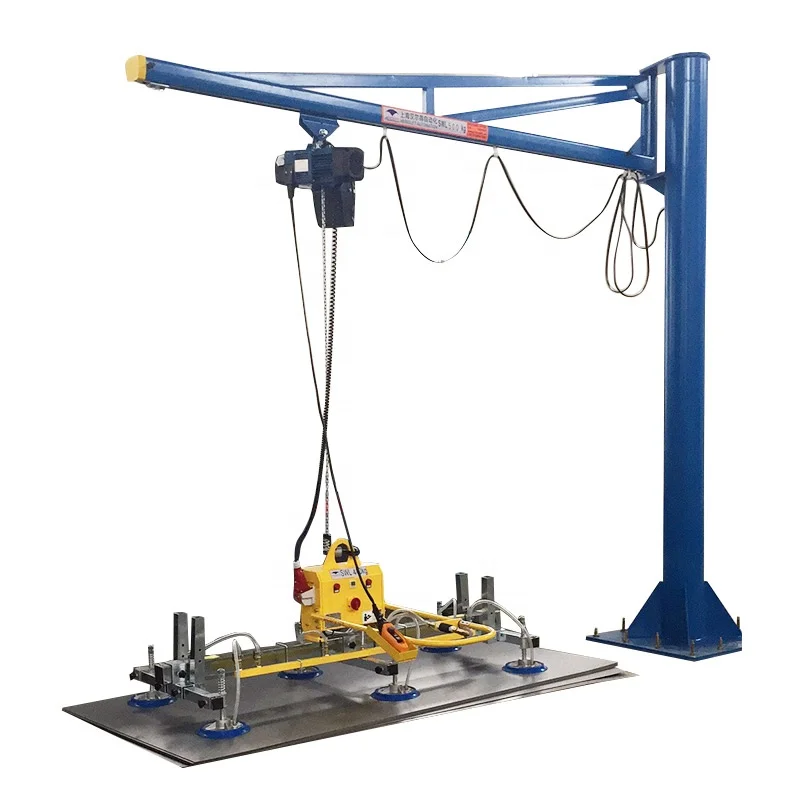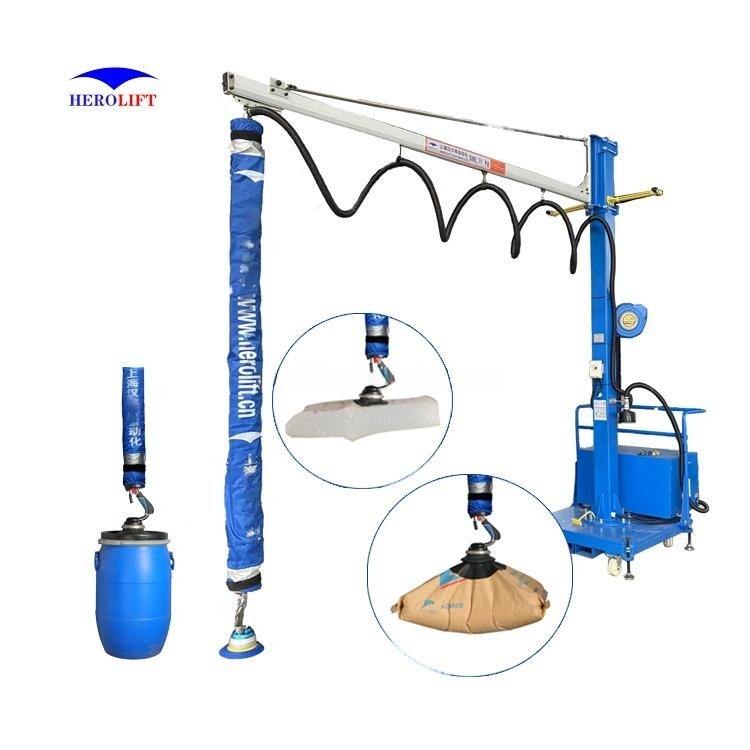공압식 진공 리프트 및 밸브 이해하기: 유압식 리프트와 비교
물류 처리 및 수직 운송 분야에서 공압 시스템은 효율성과 다용도 때문에 큰 주목을 받고 있습니다. 이 분야의 두 가지 핵심 구성 요소는 공압 진공 리프트와 공압 진공 밸브입니다. 본 문서에서는 이러한 시스템이 어떻게 작동하는지, 그 응용 방법과 유압 엘리베이터와 비교하여 그 능력에 대한 완전한 이해를 얻기 위해 살펴보겠습니다.

공압 진공 리프트란 무엇인가요?
공압 진공 리프트는 공기 압력을 사용하여 무거운 물체를 들어 옮기는 장치입니다. 이 장치는 진공을 만들어 부하의 표면에 부착하여 안전하고 효율적인 취급이 가능하게 합니다. 이러한 리프트는 유리, 시트 금속 및 포장 재료와 같이 소재가 섬세하거나 형상이 불규칙한 산업에서 특히 유용합니다.
리프트는 진공 패드, 공압 진공 밸브 및 제어 시스템으로 구성됩니다. 진공 패드는 물체에 대한 밀폐를 형성하며, 공압 진공 밸브는 공기 흐름을 조절하여 진공 상태를 유지합니다. 이 시스템은 작업자가 최소한의 신체적 노력으로 물건을 들어 옮길 수 있도록 해주어 부상 위험을 줄이고 생산성을 높입니다.
공압 진공 밸브는 어떻게 작동합니까?

공압 진공 밸브는 공압 진공 리프트의 핵심 부품입니다. 이 밸브는 진공 시스템으로 들어가고 나가는 공기의 흐름을 제어하여 리프트가 작동 중에 진공 상태를 유지합니다. 일반적으로 이 밸브는 진공에 의해 생성된 압력 차이에 따라 열리고 닫히는 간단한 메커니즘을 사용하여 작동합니다.
리프터가 작동되면 밸브가 열려 진공 패드에서 공기가 배출되며, 이를 통해 물체를 안전하게 고정할 수 있는 음압이 생성됩니다. 물체가 들어 올려지면 밸브를 조정하여 진공 상태를 유지하거나 하중을 내릴 때 해제할 수 있습니다. 이러한 정확한 제어는 리프팅 과정의 안전성과 효율성을 보장하는 데 중요합니다.
공압 진공 리프트 및 유압 리프트
공압 진공 리프트는 재료 취급을 위해 설계된 반면, 유압 리프트는 건물 내에서 사람과 물품을 수직으로 이동시키는 다른 목적을 가지고 있습니다. 이 두 시스템 간의 차이를 이해하면 그들의 각각의 용도와 장점이 명확해질 수 있습니다.
1. 작동 메커니즘:
- 공압 진공 리프트: 이러한 장치는 물체를 들어 올리기 위해 공기 압력과 진공 기술에 의존합니다. 진공은 밀폐된 영역의 공기를 제거하여 리프트가 부하에 부착할 수 있도록 합니다.
- 유압 리프트: 대조적으로, 유압 리프트는 실린더 내부에서 피스톤을 들어 올리기 위해 유압 오일을 사용합니다. 유체가 실린더로 펌프되면 엘리베이터 캐빈이 올라갑니다. 이 시스템은 일반적으로 더 강력하며 더 먼 거리에 걸쳐 더 무거운 하중을 처리할 수 있습니다.
2. -속도 및 효율성-:
- -공압 시스템-: 공압 진공 리프트는 물체를 빠르게 부착하고 분리할 수 있기 때문에 일반적으로 적재 처리가 더 빠릅니다. 이 속도는 제조업과 창고와 같은 시간이 중요한 환경에서 유리합니다.
- -수압 시스템-: 수압 엘리베이터는 가속 및 감속 속도가 느릴 수 있지만, 원활한 작동을 제공하며 긴 거리에 걸쳐 더 큰 하중을 더 효율적으로 운반할 수 있습니다.
3. -공간 요구 사항-:
- -공압 리프트-: 이러한 시스템은 일반적으로 더 컴팩트하여 공간이 제한된 공장과 작업장에서 이상적입니다.
- -수압 엘리베이터-: 수압 시스템은 수압 실린더 및 관련 부품을 설치하기 위해 더 많은 공간이 필요하므로 작은 건물에서는 사용이 제한될 수 있습니다.
4. -유지 보수 및 비용-:
- -공압 시스템-: 공압 진공 리프트는 움직이는 부품이 적고 유압 오일이 필요 없으므로 일반적으로 유지 보수 비용이 낮습니다. 그러나 진공 밀폐 상태가 온전한지 주기적으로 점검해야 할 수 있습니다.
- -유압 시스템-: 유압 엘리베이터는 유압 시스템의 복잡성과 유체 누출 가능성이 있어 유지 보수가 더 비쌀 수 있습니다. 하지만 적절히 유지 관리되면 내구성과 수명 면에서 우수합니다.
5. -응용 분야-:
- -공압 진공 리프트-: 이들은 빠르고 안전한 재료 취급이 중요한 제조, 포장 및 물류 분야에서 널리 사용됩니다.
- -유압 엘리베이터-: 유압 엘리베이터는 상업 및 주거 건물에서 흔히 볼 수 있으며 층 사이에서 사람과 무거운 물체를 운반하는 데 이상적입니다.

결론적으로
공압 진공 리프트와 공압 진공 밸브는 현대 물류 처리에서 중요한 역할을 하며, 다양한 부하를 들어 올리고 운반하기 위한 효율적이고 안전한 솔루션을 제공합니다. 이들은 유압 엘리베이터와 일부 유사점이 있지만, 작동 메커니즘, 속도, 공간 요구 사항 및 응용 분야가 상당히 다릅니다. 이러한 차이점을 이해하면 기업들이 자사의 특정 필요에 맞는 시스템을 선택하는 데 도움이 되며, 궁극적으로 작업을 더 생산적이고 안전하게 만들 수 있습니다. 산업이 계속 발전함에 따라 공압 진공 리프트와 같은 효율적인 리프팅 솔루션에 대한 수요는 증가할 가능성이 있어 물류 처리 세계에서 중요한 부분이 될 것입니다.

 EN
EN
 AR
AR
 HR
HR
 DA
DA
 NL
NL
 FR
FR
 DE
DE
 EL
EL
 IT
IT
 JA
JA
 KO
KO
 NO
NO
 PL
PL
 PT
PT
 RO
RO
 RU
RU
 ES
ES
 SV
SV
 TL
TL
 ID
ID
 LV
LV
 LT
LT
 SR
SR
 SL
SL
 UK
UK
 VI
VI
 HU
HU
 TH
TH
 TR
TR
 AF
AF
 MS
MS
 GA
GA
 BE
BE
 MK
MK
 AZ
AZ
 UR
UR
 EO
EO
 LA
LA
 MN
MN
 KK
KK





















